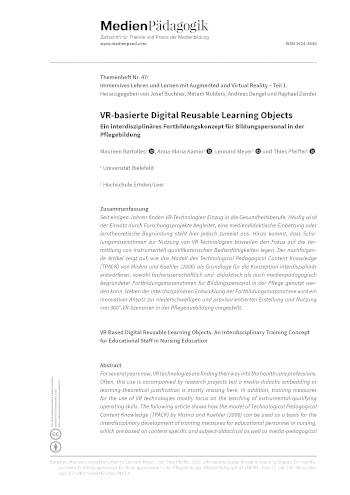Abstract
For several years now, VR technologies are finding their way into the health care professions. Often, this use is accompanied by research projects but a media-didactic embedding or learning-theoretical justification is mostly missing here. In addition, training measures for the use of VR technologies mostly focus on the teaching of instrumental-qualifying operating skills. The following article shows how the model of Technological Pedagogical Content Knowledge (TPACK) by Mishra and Koehler (2006) can be used as a basis for the interdisciplinary development of training measures for educational personnel in nursing, which are based on content-specific and subject-didactical as well as media-pedagogical knowledge. In addition to the interdisciplinary development of the training measures, an innovative approach for the low-threshold and practice-oriented creation and use of 360°-VR-scenarios in nursing education is presented.
References
Bartolles, Maureen, und Anna-Maria Kamin. 2021. «Virtual Reality basierte Digital Reusable Learning Objects in der Pflegeausbildung - Rahmenbedingungen, Anforderungen und Bedarfe aus medienpädagogischer Perspektive». Working Paper-Reihe der Projekte DiViFaG und ViRDiPA. https://doi.org/10.4119/UNIBI/2954329.
Bauman, Eric B. 2012. Game-Based Teaching and Simulation in Nursing and Health Care. New York: Springer.
Baumgartner, Peter. 2004. «Didaktik und Reusable Learning Objects (RLOs)». In Campus 2004: kommen die digitalen Medien an den Hochschulen in die Jahre?, herausgegeben von Doris Carstensen und Gesellschaft für Medien in der Wissenschaft, 309–25. Medien in der Wissenschaft, Bd. 29. Münster: Waxmann.
Baumgartner, Peter, und Marco Kalz. 2005. «Wiederverwendung von Lernobjekten aus didaktischer Sicht». In Auf zu neuen Ufern! E-Learning heute und morgen, herausgegeben von Djamshid Tavangarian, Kristin Nölting, und Gesellschaft für Medien in der Wissenschaft, 97–106. Medien in der Wissenschaft 34. Münster: Waxmann.
Bracq, Marie-Stéphanie, Estelle Michinov, und Pierre Jannin. 2019. «Virtual Reality Simulation in Nontechnical Skills Training for Healthcare Professionals: A Systematic Review». Simulation in healthcare: journal of the Society for Simulation in Healthcare 14 (3): 188–94. https://doi.org/10.1097/SIH.0000000000000347.
Buchner, Josef, und Diane Aretz. 2020. «Lernen mit immersiver Virtual Reality: Didaktisches Design und Lessons Learned». Herausgegeben von Klaus Rummler, Ilka Koppel, Sandra Aßmann, Patrick Bettinger, und Karsten D. Wolf. MedienPädagogik: Zeitschrift für Theorie und Praxis der Medienbildung, Jahrbuch Medienpädagogik, 17 (Jahrbuch Medienpädagogik): 195–216. https://doi.org/10.21240/mpaed/jb17/2020.05.01.X.
Delere, Malte. 2020. «Konzepte medienpädagogischer Kompetenz von Lehramtsstudierenden in deutschsprachigen und internationalen Studien – ein systematisches Literaturreview». Medienimpulse, Juni: 1-57. https://doi.org/10.21243/MI-02-20-16.
Eiris, Ricardo, Masoud Gheisari, und Behzad Esmaeili. 2018. «PARS: Using Augmented 360-Degree Panoramas of Reality for Construction Safety Training». International Journal of Environmental Research and Public Health 15 (11): 2452. https://doi.org/10.3390/ijerph15112452.
Grassini, Simone, Karin Laumann, und Martin Rasmussen Skogstad. 2020. «The Use of Virtual Reality Alone Does Not Promote Training Performance (but Sense of Presence Does)». Frontiers in psychology 11: 1743. https://doi.org/10.3389/fpsyg.2020.01743.
Härtel, Michael, Marion Brüggemann, Michael Sander, Andreas Breiter, Falk Howe, und Franziska Kupfer. 2018. Digitale Medien in der betrieblichen Berufsbildung: Medienaneignung und Mediennutzung in der Alltagspraxis von betrieblichem Ausbildungspersonal. Bonn: Bundesinstitut für Berufsbildung. https://nbn-resolving.org/urn:nbn:de:0035-0750-8.
Kavanagh, Sam, Andrew Luxton-Reilly, Burkhard Wuensche, und Beryl Plimmer. 2017. «A systematic review of Virtual Reality in education». Themes in Science and Technology Education 10 (2): 85–119. http://earthlab.uoi.gr/theste/index.php/theste/article/view/241.
Koehler, Matthew J. 2011. «Using the TPACK Image». TPACK ORG (blog). 11. Mai 2011. http://tpack.org/.
Koehler, Matthew J., Punya Mishra, und William Cain. 2013. «What Is Technological Pedagogical Content Knowledge (TPACK)?» Journal of Education 193 (3): 13–19. https://doi.org/10.1177/002205741319300303.
Lerner, Dieter. 2021. «Virtuelle Realitäten in der Pflegebildung?» Lehren & Lernen im Gesundheitswesen, Nr. 05: 55–61. https://doi.org/10.52205/llig/06.
Mishra, Punya. 2019. «Considering Contextual Knowledge: The TPACK Diagram Gets an Upgrade». Journal of Digital Learning in Teacher Education 35 (2): 76–78. https://doi.org/10.1080/21532974.2019.1588611.
Mishra, Punya, und Matthew J. Koehler. 2006. «Technological Pedagogical Content Knowledge: A Framework for Teacher Knowledge». Teachers College Record 108 (6): 1017–54. https://doi.org/10.1111/j.1467-9620.2006.00684.x.
Müller, Klaus. 2013. «Lernaufgaben». In Pflegedidaktische Handlungsfelder, herausgegeben von Roswitha Ertl-Schmuck und Ulrike Greb. Pflegepädagogik. Weinheim and Basel: Beltz Juventa.
Niess, Margaret L. 2017. Technological Pedagogical Content Knowledge (TPACK) Framework for K-12 Teacher Preparation: Emerging Research and Opportunities. Advances in Educational Technologies and Instructional Design. IGI Global. https://doi.org/10.4018/978-1-5225-1621-7.
Pfeifer, Lydia, Annette Nauerth, Patrizia Raschper, Christiane Freese, und Sophia Bräkling. 2021. «Virtual Reality basierte Digital Reusable Learning Objects in der Pflegeausbildung - Rahmenbedingungen, Anforderungen und Bedarfe aus pflegepädagogischer Sicht». Application/pdf, 718210 bytes. https://doi.org/10.4119/UNIBI/2954330.
Reinmann, Gabi. 2013. Didaktisches Handeln. Die Beziehung zwischen Lerntheorien und Didaktischem Design. Frankfurt. https://l3t.tugraz.at/index.php/LehrbuchEbner10/article/view/93/.
Reinmann, Gabi. 2015. «DIDAKTISCHES DESIGN». Universität Hamburg. https://gabi-reinmann.de/wp-content/uploads/2013/05/Studientext_DD_Sept2015.pdf.
Schmid, Mirjam, und Dominik Petko. 2020. «‹Technological Pedagogical Content Knowledge› als Leitmodell medienpädagogischer Kompetenz». Herausgegeben von Klaus Rummler, Ilka Koppel, Sandra Aßmann, Patrick Bettinger, und Karsten D. Wolf. MedienPädagogik: Zeitschrift für Theorie und Praxis der Medienbildung, Jahrbuch Medienpädagogik, 17 (Jahrbuch Medienpädagogik): 121–40. https://doi.org/10.21240/mpaed/jb17/2020.04.28.X.
Schröder, Dimitri. 2017. «Virtual Reality Simulation in der Pflegeausbildung: Empirische Untersuchung des Lerneffektes». Bachelorarbeit, Bielefeld: Fachhochschule Bielefeld.
Snelson, Chareen, und Yu-Chang Hsu. 2020. «Educational 360-Degree Videos in Virtual Reality: A Scoping Review of the Emerging Research». TechTrends 64 (3): 404–12. https://doi.org/10.1007/s11528-019-00474-3.
Thompson, Ann D., und Punya Mishra. 2007. «Breaking News: TPCK Becomes TPACK!» Journal of Computing in Teacher Education 24 (2): 38–64. https://doi.org/10.1080/10402454.2007.10784583.

